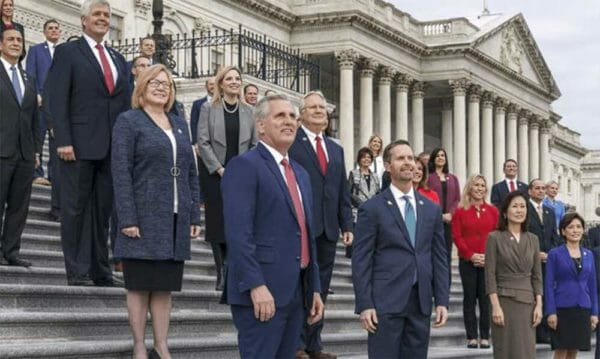
United States – -(AmmoLand.com)- As the 117th Congress kicks off, there will be a lot of legislation introduced. In fact, we noted over 14,000 bills were introduced in the 116th Congress. This leads to one big question: How does Congress deal with so much legislation? Hard for every member of Congress to read every bill, then cast a vote… in fact, impossible. So, while that might seem like good news, it really is more of a mixed blessing.
Why? Because loyal Ammoland readers know of a number of good bills that should be passed into law, from deregulating certain rifles used for self-defense and competitions to improving protections for travelers to bringing firearms sales to the 21st Century, to list a few short-term improvements. Those are just a few examples from the last Congress. We may see more bills introduced this Congress, but how do you get 435 members of the House of Representatives and 100 Senators to study the legislation.
Answer: They don’t.
Both the House of Representatives and the Senate established a number of committees each specializing in certain areas. Bills involving our Second Amendment rights will go to the House Judiciary Committee and the Senate Judiciary Committee. Each of those committees have a number of subcommittees.
So, when bills are introduced, they are sent to the committee for consideration. The committee then hands it off to a subcommittee. Most bills then just languish in subcommittee from their introduction to the end of the Congress, when they die, often to be reintroduced the next Congress.
The committees and subcommittees are run by chairmen. Chairmen come out of the majority party in either body. But who gets to be a chairman? Most of the time, seniority is the determining factor. Chairmen of committees often have spent decades in the House or Senate – and the subcommittee chairmen are also racking up seniority as well. If the chairman supports a given bill, it is more likely to get through the committee and get to the floor. If they oppose the bill… well, no luck.
This is one reason that the National Rifle Association often maintained their “friendly incumbent” policy. A committee chairman can kill bad bills outright, he can use his (or her) influence to mitigate the bills when they can’t be stopped outright, and they can also move good legislation forward, and even if that chairman is not the chair of the House or Senate judiciary committees, they will still have plenty of influence (see how John Dingell helped defeat the effort to kill gun shows in 1999).
The current Congress will be a harsh battleground for the next two years. Second Amendment supporters and loyal Ammoland readers can get started on the fight to restore pro-Second Amendment control of both chambers of Congress by supporting the NRA’s Institute for Legislative Action and Political Victory Fund.
About Harold Hutchison
Writer Harold Hutchison has more than a dozen years of experience covering military affairs, international events, U.S. politics and Second Amendment issues. Harold was consulting senior editor at Soldier of Fortune magazine and is the author of the novel Strike Group Reagan. He has also written for the Daily Caller, National Review, Patriot Post, Strategypage.com, and other national websites.


I would like to see term limits on congress. That would definitely put a dent in the unholy seniority system. Unfortunately, I will not see anything close to term limits in my lifetime….
Two points to think about, before instituting term limits:
1) Term limits already exist! They are controlled by regular elections, and the people may remove any member at any election.
2) Term limits do have one very significant down-side. Excellent members (such as the entire delegation from Oklahoma) would not be allowed to gain significant seniority.
I agree. Legislative constraints are no remedy for bad voting or non-voting.
It’s already difficult enough to get a group of voters to work like hell to get a reasonable person elected. If they know their efforts will be overturned by the passage of time, it will be even more difficult to organize grass roots efforts to get reasonable people elected.
Totalitarians, however, are much more inclined to organize, communicate, and take action to advance their policies. Term limits will have no effect on their tireless efforts.
B/S the idiots that keep voting these carrier politicians in to get their pet projects through, Line Item Veto’s, and Term Limits, would tie their hands some what! Term Limits should be set the same as the President, no more than ten years max, this would also work for the Supreme Court Judges also not a Lifetime Job!!!!!!!!!!!!!!! You know that the politicians won’t do that as they won’t cut off their nose to spite their faces!!!!!!!!!!!!!
President and Veep can do 8 years, not 10. Term limits are a good thing. They keep pols from creating little kingdoms of control. That would lessen with term limits. I’ve read, somewhere, that this kind of organization should have a 30% turnover every few years to stay fresh.
Veep can get close to 10 years. If Biden makes it past two years by even a day – Kamala becomes president for remainder of that term (almost two years) then is eligible to be reelected twice for a total just shy of 10 years. I predict that B/H will be replaced in four years given that driver for Biden’s election was dislike of Trump – and extremism of their (Biden/Harris) policies. I kind of expect republican resurgence in two years – shifting several house seats and maybe taking a few senate seats. Wouldn’t take much to totally stymie further… Read more »